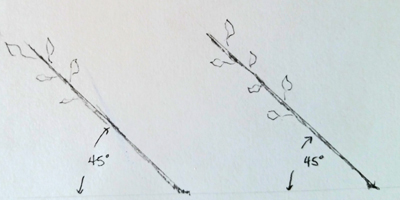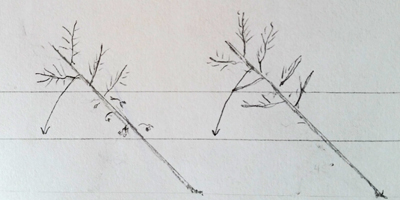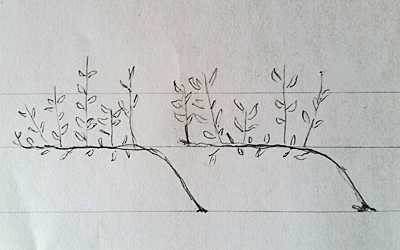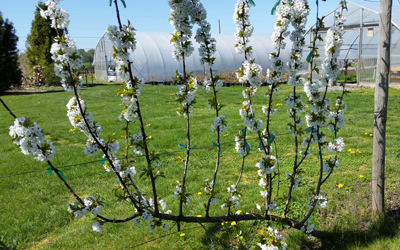Many visitors to Cloud Mountain are intrigued by our ‘cherry tunnel’. This upright fruiting system (UFO) is an unusual way of growing sweet cherries. It was initially developed for commercial growers, but can be adapted to home gardens and market farms as well.
The Upright Fruiting Offshoots (UFO) system for sweet cherries was developed to:
- Simplify training, pruning, and crop management
- Achieve high, uniform light distribution to fruiting branches
- Utilize the sweet cherry’s natural upright growth habit and manage vigor by establishing multiple vertical structural fruiting units
At maturity, the UFO system yields a fruiting wall that is precocious, productive, and simple to maintain. Each tree is comprised of a permanent single horizontal trunk from which renewable fruiting shoots are grown vertically. Fruit are borne predominantly on spurs but also at the base of 1-year-old shoots, all on vertical wood. The UFO system is most easily configured to a single vertical plane, requiring trellising (about five wires). UFO training may be used to establish a orchard where very short or no ladders are needed, though higher yields in the single vertical wall UFO can be achieved by maintaining a tree height of 12’-15’ high.
Establishing the UFO system is straightforward with little to no pruning required at planting.
Spacing:
- Space rows 9’-10’ apart
- In the row, space trees 5’-6’ apart (Gisela 5 Rootstock)
- Trellis should be at least 5 wires, lowest wire at 20”, then spaced every 18”-20”
At planting
-

At planting
Unheaded and unbranched (whip) trees are recommended.
- Plant trees at a 45-degree angle pointing the terminal to the south in rows that run north to south. This reduces the potential for sunburn on the trunk during establishment. Important: do not plant the trees vertically and bend them to a 45-degree angle.
- Clip or tie the trunk where it intersects the lowest wire (20 inches above ground) to maintain the planting angle.
- Remove any nursery tree branches with thinning cuts.
- Manually rub off all buds below the first trellis wire.
- Score the bark with a coarse saw blade above upper buds about every 8″ to stimulate vertical shoot formation.
First growing season
-

begin bending to horizontal
Remove any shoots that form below the first trellis wire.
- In late spring, evaluate growth uniformity of vertical shoots; head any excessively strong shoots to a stub of no more than 2 inches with several leaves to promote regrowth of each as new dual shoots to be more in balance with the existing moderate shoots.
- Once new shoots at the terminal end are 12 inches or longer, train trees to the lowest wire by removing the initial tie andplacing it further along the trunk so that the orientation is slightly above horizontal.
First dormant season
-

Trunk is pulled to just above horizontal.
Thin shoots to approximately 8-10 inches apart, choosing moderate vigor shoots over weak or highly vigorous ones. Trim shoots so that all shoots are growing at same vertical height as much as possible.
- Where possible, clip or tie shoots to the second wire.
- Using thinning cuts, remove any shoots growing below horizontal from the main leader.
Second growing season
- Where gaps on the horizontal trunk exist, score above upper facing buds to promote completion of vertical shoot formation.
- Tie or clip upright shoots to successive vertical trellis wires as growth allows.
- Using thinning cuts, remove any new shoots from below the first trellis wire.
- In late spring, evaluate growth uniformity of new vertical shoots; cut back any excessively strong shoots to a stub of no more than 2 inches with several leaves to promote regrowth of each as new dual shoots to be more in balance with the existing moderate shoots.
- In mid-summer, remove excessively vigorous uprights with a thinning cut.
Second dormant season
-

3 year old UFO cherry in bloom
Thin out weakest or most vigorous leaders if density exceeds one per approximately 8 inches
- For highly productive varieties, remove all lateral shoots on upright leaders with thinning cuts; on moderately productive varieties, remove all lateral shoots on upright leaders with stub cuts (i.e., leaving three to seven buds at the base of the lateral shoots for additional fruiting). NOTE: this removal of lateral shoots also can be done by summer hedging about 4 to 6 weeks after harvest.
- Tie or clip upright shoots to wires.





I am a sweet cherry grower in Belgium and a big fan of the SSA and especially of the UFO system and already using both systems.Up to now I planted the self fertile variete Grace Star in both systems because she has little tendancy to create blind wood.
In the following years I will plant other varietes such as Benton in the UFO system.,
There is only one question that remains:”Which varietes are the most suitable ones for the UFO system?”
We’re using many sweet cherry cultivars that are proven for our maritime climate. Right now, Rainier is proving to be quite successful with this system, as are Hartland, Early Burlat and Lapins (that one needs thinning). Most of our experience is inside a tunnel (covered after bloom).
I’m thinking of planting 2,000 cherry trees in a UFO system. but I’m worried about some things. after 8 years many eyes will be lost what will we do? do you have any photos or videos to show me a field how it is after 8 years?
Hi we are looking putting in the Y UFO system. I am wondering at what angle do the Y shape trellis need to be at? How far would the next row Trellis pole be from the 1st row. I cant seem to find any info on building the Trellis system itself. Thank you so much for any information you can provide.
60% is the recommended angle. WSU has a pdf aimed at commercial growers on Tatura trellis system, another term for the UFO Y trellis